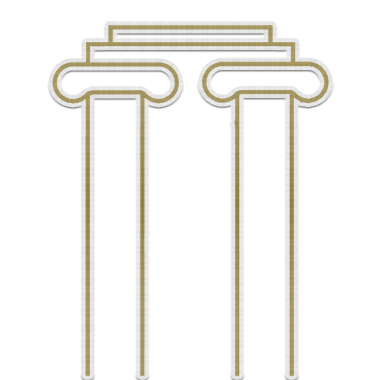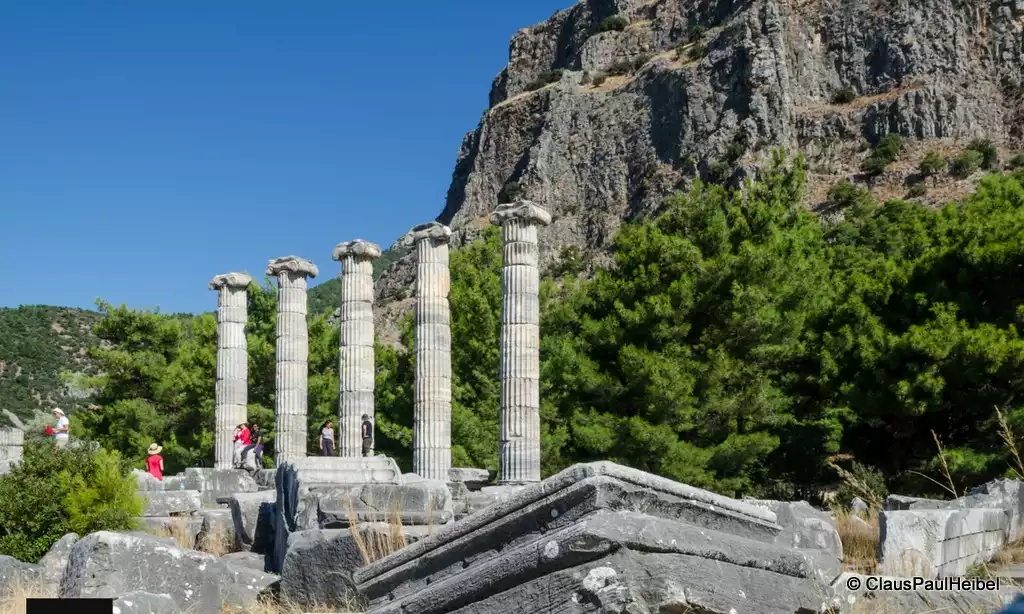It is believed that the name of Priene is not Greek but is related to pre-Greek names of Cretan origin. In recent years, the theory gains weight that Priene was one of the cities of the Kingdom of Ahhiyava, which is believed to have been founded in the Miletus region, and that its name also derives from that origin. Therefore, our knowledge of the initial foundation of the city, whose existence goes back to the 2nd millennium BC, rests on hypotheses. The fact that the location of the pre-4th century BC Priene has not yet been able to be determined up to the present day. According to the information from ancient sources, Pausanias has written that Priene was founded by Aipythos, son of Neleus of Athens, and by Philotas of Thevai, and that the native population was Carian, whereas Strabo gave the information that the city was founded by Philotas and that it was then called Kadme.
It is also believed that Priene was founded (like Ephesus) by Amazon queens.
Archaeologists on the other hand, basing their claim upon the results of certain research, say that the first city was actually located at its present site, but because of the rising level of the land, due to its filling up with alluvial deposits of river Meander, it had remained inland and that during this period the outlet of the city was provided by the port of Naulochos. Another hypothesis is that the city was situated not in the Meander valley, but in the northern part of the mountain of Samson (Mount Mycale). Furthermore, it is identified with the much destroyed city of Melie situated within the ruins of the fortress visible here.The city would have outlets via two ports, one in the north, and the other in the south (Naulochos). The information gathered from ancient sources and from recent theses differ widely. Nevertheless, to conclude, it is accepted that Priene was a small city, that it was situated on a peninsula close to Miletus and that it had two ports.
Since The site of this first city could not be determined and no concrete findings have been obtained. The only piece found is the electrum coin discovered in Clazomenae. This coin, with the head of Athena on it, and which can be dated back to 500 BC, is evidence that Priene was attached to the Ionian League.
The city which, it is certain, was linked to the Panionion from its foundation onward, was, like all Ionian cities, attacked by the Kimmers in the mid-7 th century BC, but since this sack was of a transitory nature, the city recovered in a short time. At the end of the 7th century BC, Priene was captured by the Lydians and remained for some time under the rule of this kingdom.
The 6th century BC was the most prosperous era of Priene, as for all other Ionian cities. In the beginning of 6th century BC, Bias, one of the “Seven Sages” was born in Priene, and he put into order the laws of his city. This brilliant era ended in 545 BC when Mazares, the commander of the Persian king Cyrus, attacked the city, burnt it down completely and enslaved its people. After a difficult period, Priene participated in the Ionian revolt against the Persians started in 500 BC and joined the Battle of Lade with 12 ships.
Since The site of this first city could not be determined and no concrete findings have been obtained. The only piece found is the electrum coin discovered in Clazomenae. This coin, with the head of Athena on it, and which can be dated back to 500 BC, is evidence that Priene was attached to the Ionian League.
After a difficult period, Priene participated in the Ionian revolt against the Persians started in 500 BC and joined the Battle of Lade with 12 ships. However, as a result of the Persians completely destroying the Ionian fleet, the city was sacked agaia The Persian fleet, defeated after its attacks on Athens, had to retreat and take refuge in the bay in front of Mycale, whereupon the Spartans attacked and burnt the whole Persian fleet (479 BC). The “Attic-Delian Sea League” was founded immediately following upon this battle and victory, and Priene joined it in 450 BC. In 442 BC the Samos-Priene war came to an end through the mediation of this league. Up to the mid-4th century, the city, though at times under the influence of Athens, was more under the domination of the Persians. After the death of Mausolus (353 BC) the Persian satraps came under the rule of Athens. According to findings and remains, the re-funding of the city of Priene coincides with this period.
During the Hellenistic period, which began with the victory of Alexander the Great over the Persians and his capturing of Anatolia, all Ionian cities showed great prosperity. Alexander the Great gave the cities autonomy and abolished the excessive taxes paid to the Persians.
It is known that when Alexander besieged Miletus and the city resisted, he came to Priene and stayed there for some time and he made a donation to the Temple of Athena. After the death of Alexander the Great, his commander Lysimachus ( 287 BC) came into power. Lysimachus acted as mediator between Samos and Priene to solve the misunderstanding about borders that had been going on for a long time. He re-conciliated the two parties and gave Dryussa (north of Mycale) to Priene (283-82 BC) During the Hellenistic period, the city came under the rule of the Ptolemaic and Seleucid Kingdoms and the Kingdom of Pergamum. Prince Graphemes who had spent his childhood in Priene, came to rule the Kingdom of Cappadocia in 158 BC, but when he was banished from the throne a short time later, he left the state treasury to Priene for protection.
His brother, King Ariarathes V of Cappadocia, asked for the treasury to be given
back, but the Prieneans replied that they could only give it back to the person
who had entrusted it to them and rejected the request, whereupon Ariarathes V and
the King of Pergamum, Attalus II, attacked Priene together and destroyed the city completely (155 BC).
Later in time, the treasury was given back to Orophernes who, in return for this kindness, made a considerable donation to the city and worked hard for its prosperity. Treaties made in 196 and 188 BC were not able to put a stop to the fight over borders between Samos and Priene. In 135 BC, through a decree issued by the Senate of Rome, Dryussa was definitely joined to Priene and the misunderstanding was thus ended After the death of King Attalus II of Pergamum in 133 BC, his lands were attached to Rome in conformity with his will, and Priene thus came under Roman rule. During the Roman period, Priene went through very difficult days because of the many wars and especially the attacks of pirates, and could only achieve a more peaceful period during the reign of Emperor Augustus.
In the 1st century BC, one of the arms of the Meander river, flowing out to the sea, provided a connection to the port, but as time went by, the alluvial mud brought down by the river caused the sea to move continually away from the city, and the connection to the port was cut off. This caused the city started to loose its interest, and Priene began to be abandoned. In the Byzantine period the city was a bishopric, and findings prove that, until the fall of the empire, it was still populated. At the end of this period Priene was completely deserted.
Location Map of Old Priene
Prien City Plan
map explanation by DidimGuide
2 temple of Demeter
1 is hidden on the map but shows where you are; is where you start your visit just after ticket office
3 terrace Houses
4 harbour Road
5 Temple of Athena where is the best spot to take full picture of Soke plain untill the sea. Notice, as far as eye can see used to be sea.
6 where the stairs going down to the agora (shopping arcade or political in those times)
7 Theatre where you will see an amazing theatre with armchairs carved into the stone
8 Later period; late Roman – Byzantine Chapel.
9 Upper gymnasium
10 Governal Buildings facing to Agora
11 Lover gymnasium facing to Agora
12 Prytaneum
13 Bouleuteriun
14 Stadium
15 temple of Zeus
16 Agora
17 famous fish market
18 west harbour
19 Houses
20 is hidden on this map where blue arrows finally end up at the norhern gate of the city is also exit
Some of the important buildings in the Priene ruins are as follows:
The Temple of Athena: It is the ruin of a monumental temple which can be first seen from the plain with its five standing Ionic columns. Its architect was one of the architects of the Mausoleum in Halicarnassus (Bodrum), Pytheos.
Along Its long sides, there were eleven, and on its short sides, there were six columns. This kind of temple surrounded by only a single row of columns was called peripteros. The peripteros in Priene is a mature example of the Ionic order.
the Priene Theatre: In the Greek theatres, there was only a round orchestra in front of the audience without the high stage and the backstage which were the characteristic of the Roman theatres. In the Roman period all Greek theatres were changed into Roman theatres.
The Priene theatre, very well preserved, the best example of the Greek theatres in western Anatolia still retaining its original characteristics.
Bouleterion: It is a conference hall with its cornered structure forming an amphitheatre in three sides. Its roof, standing on vails and two-cornered columns on the sides, was covered with wooden planks. There was an altar in its centre. Rectangular shaped altar has bulls head motive carved on it. The city council met there.
The Prytaneion: the state guest house where high-ranked officials worked and where fire burned the sacred-fire continuously was located east of the Bouleterion.
The Upper Gymnasium: Although of Hellenistic period, the building under-vent certain changes from time to time; in the Roman period, a bath was add-;d and eventually, in the Byzantine period, it was changed into a church.
The Lower Gymnasium: It is close to the southern ramparts of the city, built in the 2nd century B.C., surrounded by a gallery with columns. It has an open exercise hall, bath rooms and exercise rooms.
The Agora: It is in the centre of the city, built in the 2nd century B.C. Its northern side was open to the street, the other three sides surrounded by stoa’s. In 130 B.C. a 116 meter gallery was donated as a gift by the King of Cappadocia -Ariartes IV (Orophenes) behind the street on the northern side as sacred stoa.
How to get to Priene Ancient Town
If you are travelling from Altinkum or Akbuk:
Public transport to Priene
Easy way to go to priene is to go to SOKE first. At the last stop where all busses are coming to in Soke change to Gullubahce Birlik minibusses. Their last stop is Turunclar Mahallesi where Priene is. When you reach Turunclar district you will see the remainings of an AquaDuct where is also known as Selale Restaurant (Selale = waterfall in Turkish). You can follow the road up to ticket office where the entrance of Priene.
For individual travellers: There’s no regular transport service between Akkoy to Priene. If You think you can drop off at the Akkoy village and visit Milet ancient Town first then to carry on to Priene you have to catch Balat Birlik minibusses From Milet ancient town to Priene.
When you are there in Priene, From Turunclar Mahallesi (next to Selale Restaurant) to Soke there are regular minibus services provided by Gullubahce Birlik Local transport company of Gullubahce Municipality.
if you are travelling by rental car
The easy way from Altinkum or Akbuk is to pass through Akkoy Village. So, you can visit Milet ancient town first. Then you can carry on to Priene. Maybe after having luch you can carry on to Millipark (Dilek Peninsula National Park) before Kusadasi where natural coves and the beaches are.
if you are travelling from Kusadasi or izmir
You have to come to Soke town first where to change to Gullubahce Birlik Minibusses.
if you are driving from Izmir – Soke direction
After Soke take the road on the right side where indicated yellow sign posts are visible Priene, Milet on them.
individual travellers using public transport
can take Didim Seyahat or Soke Seyahat coach companies direct to Soke. change the bus at the last stop to Gullubahce Birlik.
or you can take local minibus runing regularly between Didim to Güllübahce “Balat Birlik”
Visit Priene firstly where public transport is guaranteed back to Soke. After Priene then you can take bus back to Didim. If you want to visit Milet Ancient town in the same day (Milet Ancient town is 3-4 kilometres from Akkoy village) You can drop at Akkoy for Milet.
You can find bus back to Didim from Akkoy in every 15 minutes.
You can take guided tours by travel agents or your tour operator visiting Didyma – Miletos – Priene in the same day.
 Didim Guide
Didim Guide




